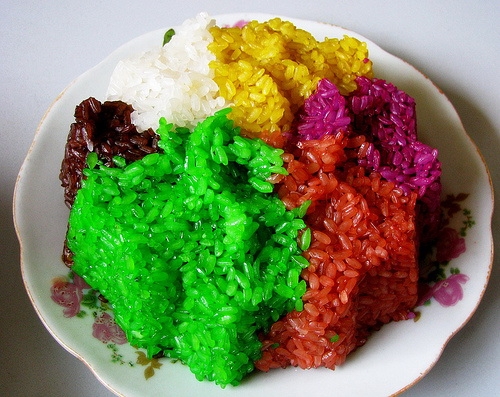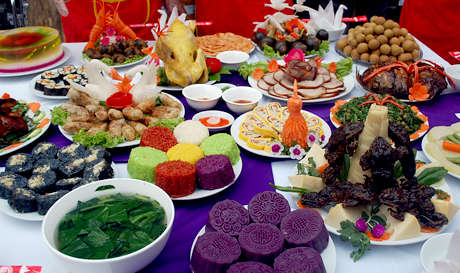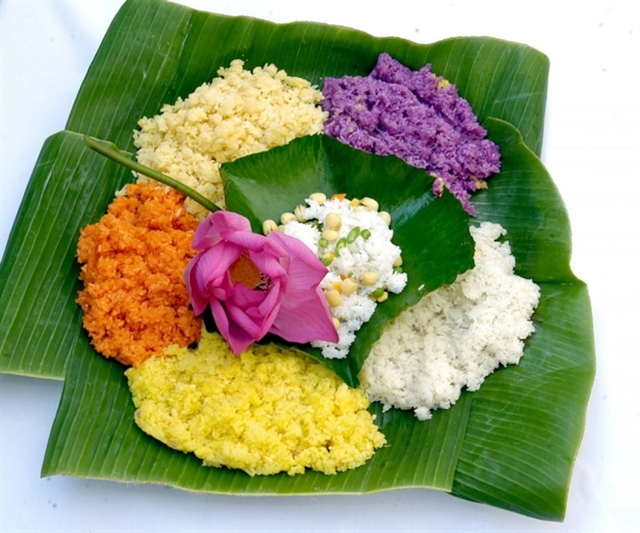 Life & Style
Life & Style

Xôi bảy màu (seven-coloured) sticky rice of Lào Cai Province was recently chosen as one of top 100 best culinary dishes of Việt Nam by Vietkings.
Quý Dương
Xôi bảy màu (seven-coloured) sticky rice of Lào Cai Province was recently chosen as one of top 100 best culinary dishes of Việt Nam by Vietkings.
The Việt Nam Record Association (Vietkings) said the dish carries the profound traditional culture of the Nùng Dín ethic group in Mường Khương Town – the birthplace of the dish – not only for its culinary value but also the spirituality of the group.
Lều Dín Seo, 68, from Tùng Lâm Hamlet of Mường Khương Town, said the dish is dyed with special leaves collected from the forests or in gardens.

|
| Colourful sticky rice is considered a symbol of Nùng Dín ethnic group in Lào Cai's Mường Khương Town. — Photo travelmag.vn |
“These leaves are handed down from my grandfather for us to follow for a hundred years,” she said, adding that local people have never used any chemicals or colourings in the dish.
The seven colours include purple, red, blue, yellow, green, brown and white. Glutinous rice to cook the dish should be picked from the mountain because it has natural fragrance and is softer compared with others.
Seo said the process of dying the dish is rather complicated. After picking up the red, camellia and purple magenta leaves in the forests, they are boiled for 20 minutes and used to soak the glutinous rice for 6-8 hours before being steamed.

|
| A tray of dishes and fruits including xôi bảy màu is ready to celebrate the Nùng Dín people's victory against foreign aggressors on the first lunar day of the seventh lunar month. — Photo travelmag.vn |
“We use turmeric roots and ginger leaves to make yellow and green colours,” said Seo, noting that she also knows how to combine colours by using a special shrub (locally known as cây mông hoa) to make the dish more attractive and tasty. The leaves also have medicinal properties.
Seo said that to make a quality and brightly coloured dish, it depends on the experience of the chef.
She recalled the dish came into being due to a famous battle. Long ago, the Nùng Dín people bravely fought against foreign aggressors. After seven months of hard fighting, many locals had been killed and sacrificed themselves to protect their border land, they won by defeating the enemy on the first lunar day of the seventh lunar month.

|
| Visitors to Lào Cai's Sa Pa will be served quality hot and fragrant colourful sticky rice from a steamer. — Photo travelmag.vn |
To celebrate, they agreed that the very first lunar day of the seventh lunar month should be an official festival. They held a competition on how to cook the seven-colour sticky rice, reflecting the seven-month struggle against the foreign enemy.
The green represents spring, dark red for the blood of people who sacrificed themselves, the yellow of sorrow and bright red symbolising their heroic victory, said Seo.

|
| Travellers often purchase a package of xôi bảy màu wrapped in a banana leaf to bring home as a gift for their relatives. —Photo travelmag.vn |
In addition, the dish is also cooked for funerals or wedding anniversaries and particularly Tết (Lunar New Year) holiday.
“Our Nùng Dín people believe that the seven-colour sticky rice will bring good luck and good health for them all year round. It also helps to show off our women’s skills and we promise to hand it down for younger generations to follow,” she said.
An official from the Lào Cai Tourism Department said the speciality has been listed as a must-try dish by all tours to the province including famous Sa Pa.
All travellers and visitors to Lào Cai are excited to try the dish, the official said.
Tô Thúy Hải from Hà Nội told Việt Nam News that she and her family often travel to Sa Pa every year to escape the heat in summer. “We enjoy the dish so much for its soft, sweet and fragrance of the glutinous rice combined with special characteristics of forest leaves in this northwestern region.
“The dish is more enjoyable with grilled chicken or minced salted black sesame,” Hải said, adding that she could feel the nature’s flavour in the dish as well as rustic traditions of locals who had created such an unforgettable dish.
The dish now is so famous that a lot of people including foreign tourists know and enjoy it. You can sample the xôi bảy màu at local markets or during the above-mentioned festivals. — VNS




